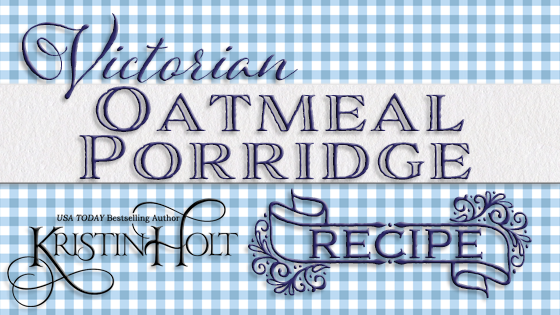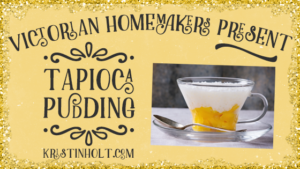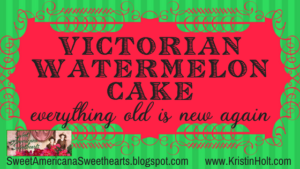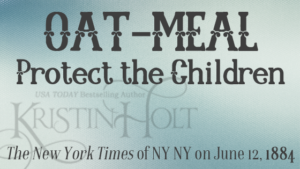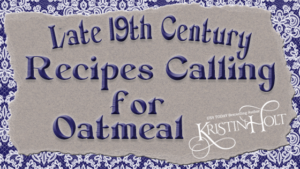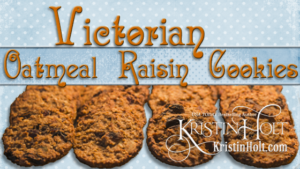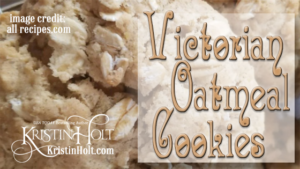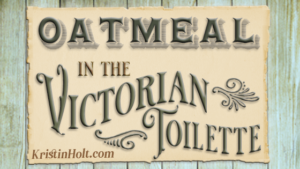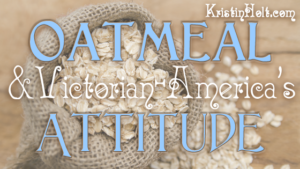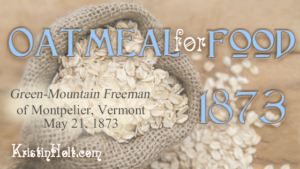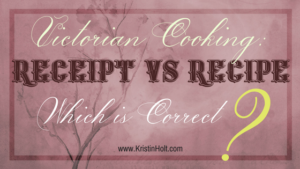Victorian Oatmeal Porridge Recipe
.
Victorian Oatmeal Porridge Recipe
.
Let it be known I am a descendant of MULTIPLE immigrant peasants. Any comment in this article that seems to be far from politically correct was stated from a Victorian-American true-to-history perspective. Victorian Oatmeal Porridge Recipe
.
~ USA Today Bestselling Author Kristin Holt
.
According to nineteenth century newspapers, American housekeepers couldn’t possibly know how to properly cook Victorian Oatmeal Porridge. With or without a recipe. Unless those housekeepers are immigrant peasants (like Kristin–see pink paragraph above). [Remember the ATTITUDE issue?] Victorian Oatmeal Porridge Recipe
“Therefore we must tell you in excruciating detail,” write those late Victorian-era newspaper men, between the lines. And often not so subtly between the lines.
.
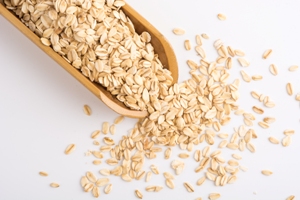
.
![]()
.
Meaningful Details
.
The following recipes– with details!— actually appeared in print. And in respectable newspapers of the day. Oats were so far off the grid for Victorian family breakfast tables or cookie jars that experienced cooks needed this information. Note the article about Oatmeal and Victorian-American Attitudes.
This “excessive” bit of instruction is worth noticing because most recipes throughout the 19th century provided next to no information about how. Cooks and bakers were expected to know how certain steps were to be accomplished. This “scant information” occurred in recipes in vintage newspapers as well as cook books of the day. See the Related Posts at the bottom (scroll down) that illustrate this mid-to-late nineteenth century “scant info” style of recipes and receipts.
Why, then, does a Victorian Oatmeal Porridge Recipe rate such detailed instructions? As you read, please ponder. Replies will remain open, as we’d all love to hear your thoughts. Because there are no wrong answers I hope you’ll feel safe offering suggestions.
.

.
![]()
.
Instructions
.
OATMEAL PORRIDGE.—The English Mechanic says clean, aromatic, coarse dry meal must be got from some shop where they know what is good in the way of oatmeal. The meal must be stored as carefully as tea in a covered dry jar, so that neither must, mice nor beetles can defile. The saucepan must be the pink of cleanliness and must not have been used for anything other than milk and bread-stuffs. Saucepans in which potatoes, greens or meats have been cooked are never pure enough for milk and bread-stuffs.–
.
PARAGRAPH OVERWHELM
.
Okay. Stop. Right here.
Yes, I’ve complained before, and I’m apt to again. What is it with these ENORMOUS Victorian paragraphs?
What was it I just read? That I need a pure porridge saucepan “in the pink of cleanliness” (ooh–I like that phrase), and must have never been used for anything but milk and bread-stuffs.
.
BREAD-STUFFS (or breadstuffs)
.
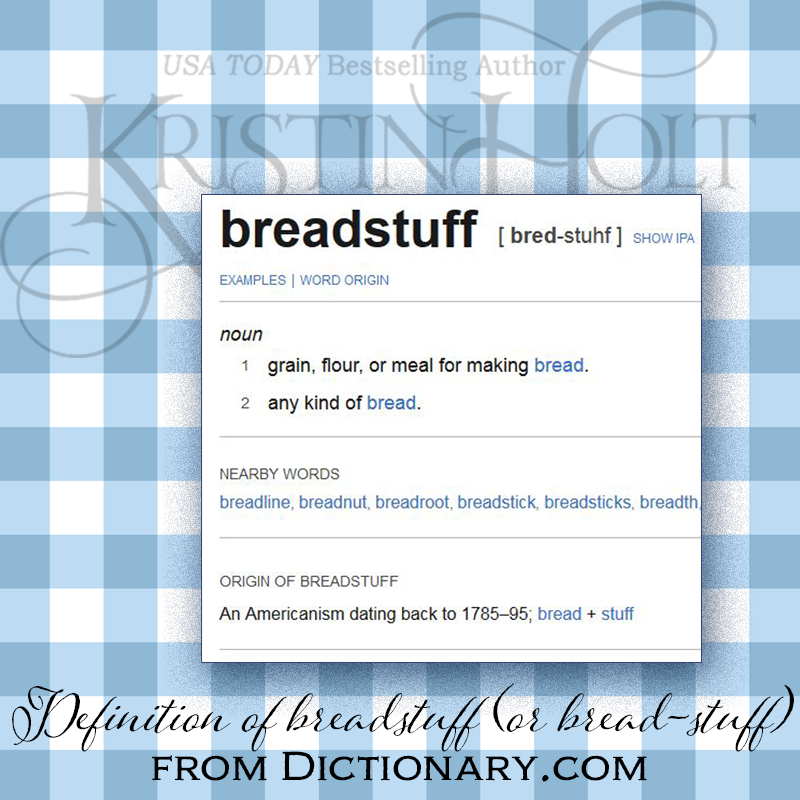
Breadstuffs Definition from Dictionary.com, styled by Kristin Holt
.
Now, where were we?
.
–With such materials, the making of delicious porridge is easy, but without them it is impossible. Bearing in mind the principle on which bread-stuffs and milk are to be combined, we perceive that the meal must be cooked in water. Therefore, having clean boiling water in the saucepan, we take a small teacup of meal (two or three ounces) for each pint of water in the saucepan. Draw the saucepan of boiling water off the fire and then sift in the meal through the fingers. The meal must be sifted into the water so as to be evenly spread over the surface, and to sink free from lumps. Then push the saucepan fully on the fire and boil briskly for a minute or two, so as to thoroughly mix the meal up with the water before it begins to thicken. Next boil slowly for three or four-quarters of an hour, according to the meal. Care must be taken that the porridge is just kept on the move, and it must be stirred, if necessary, so as to not burn and not get lumpy. Smoke and soot must be carefully kept from contaminating it. The porridge is now cooked so far that all the starch granules are full burst, and the meal is properly disintegrated. Now pour out the porridge like a thin custard into a vegetable dish, and leave it to cool uncovered. If successful, the porridge on cooling will set or gelatinize; a brownish skin forms over the surface. and as this contracts, the porridge separates all around from the dish at its edge. It becomes a soft, tremulous, jelly, perfectly cooked, sweet in flavor, uniform in consistence, and free from contamination by dirty saucepans, by burning, or by the defilement of soot or smoke.–
.
Reading took longer than cooking it
.
I’m exhausted simply reading those instructions. Do you see what I meant by Victorian recipe instructions? How others had next to none, and this one shocks us awake with step-by-step do’s and do not’s?
.
–It should be eaten at the end of breakfast with cold milk, and it makes a most excellent supper.
.
Thank you, kind sir. I’m far too weary to eat. My appetite has fled in the face of paragraphs the relative length of the Transcontinental Railway.
.
Voicing One’s 19th-Century Opinion
.
A saucepan of such porridge put into a soup plate and a half-pint mug of good rich new milk is, indeed, a lunch or a supper, or a finish to breakfast, which is fit for a king. It is food on which any man can do anything of which he is capable in the way of labor, mental or physical. For growing children, and youths who are stunted in height or unsound in structure, this is exactly the food that is wanted. It is like brick and mortar for the growing frame of infants, school children and overgrown youths. For nursing mothers it is equally valuable, supply them with the earthly phosphates and other materials out of which good milk is made, without drawing upon the mother’s own structure, as is often exemplified by the rapid softening and decay of teeth in women who nurse their children upon meat and upon beer.
.
“Oatmeal Porridge,” how to properly prepare, and how it should appear upon cooking, published in The Burlington Free Press of Burlington, Vermont on September 12, 1881. Transcribed with care to preserve punctuation, formatting, paragraph structure, spelling, etc.
Note: I emphasized “saucepan rules” and “in the pink of cleanliness” with additional bold of the type.
.

.
![]()
.
Are those Instructions Necessary?
.
No.
This recipe or set of instructions on “Oatmeal Porridge” seems excessive. Have you heard of other Victorians warn cooks about Saucepan Rules?
I do like the phrase: “in the pink of cleanliness” in reference to saucepans. I think this era-appropriate phrase must end up in a fiction title.
.

.
![]()
.
A Simpler Way
.
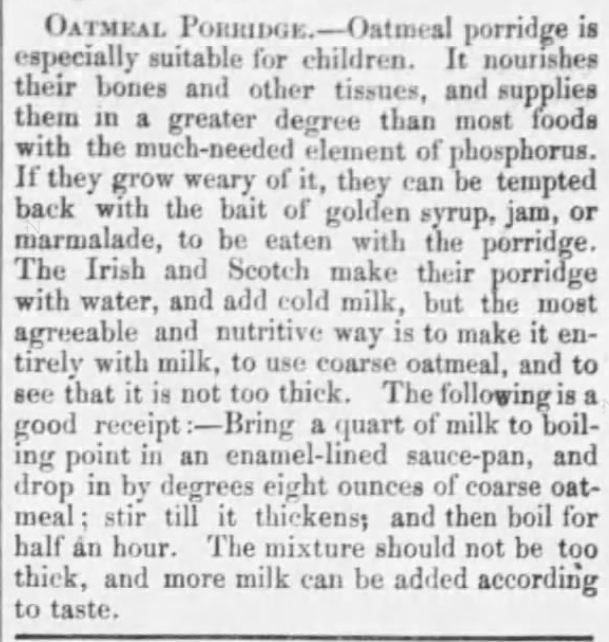
“Oatmeal Porridge” information, serving suggestions, and a good “receipt”, from New England Farmer of Boston, Massachusetts on February 10, 1877.
.
See how much simpler? Far fewer instructions (just a few lines). Much more “Victorian” in wording and presentation.
In comparison, any ideas why Victorian Oatmeal Porridge Recipe number 1 has lengthy instructions? Scroll down and leave a reply. Perhaps we can solve this historical conundrum together.
.

.
![]()
.
Microwave REAL Rolled Oats
.
I’m just saying, for those of you who like oatmeal but have never cooked whole rolled-oats at home, don’t let this Victorian over-the-top Recipe Instruction Insanity make you doubt yourself. Or oatmeal. Or think it needs to be cooked for hours. As in plural.
.
Instructions
.
One Man-sized Serving:
- Put 3/4 cup (rounded) rolled oats (the “slow cooking” kind),
- 2 cups water, and a pinch of salt into a microwave-safe oversized bowl.
- Microwave on HIGH for 3 minutes.
- Allow to cool a bit before adding milk, sugar(s), syrups, jam, or cinnamon (doesn’t work well to cook the spice into the cereal).
- Dried raisins can go in from the beginning.
- SO yummy. Requires no stirring but it can be stirred part way through if you wish. Watch through the oven door for overflows.
- EASY.
.

.
by Kristin Holt
.

.
![]()
.
Others with Scant Instructions
.
.
![]()
.
Related Articles
.
.
![]()
Copyright © 2019 Kristin Holt LC

